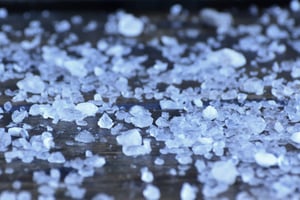With several weeks of winter left, and then the transition to spring, salt could still play a big part in keeping your property safe. Part of being prepared is knowing the specifics of the deicers you’re using on your driveway or sidewalk. Each type of deicer has different melting properties and uses. Consider all factors when choosing the product best for you.
The most common types of ice melts on the market today are chloride based.
- Sodium chloride, most commonly known as rock salt, is the most frequently used type of salt, probably because of how inexpensive it is. Working in temperatures as low as 20 degrees, this isn’t the most effective and it’s known to leave a white power behind.
- Calcium chloride is probably the most effective salt-based product, because it works up to -25 degrees. Be careful when using calcium chloride. It’s known to cause harm to plants and grass and sometimes it even damages concrete if used excessively.
- Potassium chloride has been deemed as the safer chloride-based option, working in temperatures as low as 12 degrees. It doesn’t work as well as other melting products, but people pick this product because it doesn’t harm vegetation.
Looking for products that aren’t chloride based?
- Sodium acetate works well in colder temperatures, as low as zero degrees. Its most common use is on airplane runways.
- Calcium magnesium acetate works in colder temperatures as well. Along with sodium acetate, this product is considered environmentally friendly and has a lesser chance of harming animals or vegetation.
- Ethylene glycol works in extreme cold, up to -58 degrees. However, this product is incredibly harmful for people and animals. Use extreme caution with this product, it can be deadly if ingested.

A huge concern when picking salt is knowing what is and isn’t safe for children and pets.
- There really isn’t a fully “safe” salt choice; all salts are harmful if ingested and can cause skin irritation. Even if not ingested directly, there are other ways salt can be ingested. Remember as you’re spreading salt out, you may also be getting it in nearby snow which your children or pets may decide to eat.
- Many salts say they’re “pet friendly,” but that isn’t always the case. It’s extremely important to look at labels when selecting salt – try and find a product that doesn’t have any warning labels on it. If something isn’t safe for humans, it isn’t safe for pets either. Propylene Glycol based products are generally the safest product to have around pets.
- If you’re concerned about your children or pets, look for products that don’t contain salt or chloride. These are less harmful.
- Try mixing salt with some sand to decrease the amount of salt you’re using this winter. Although sand won’t melt ice like salt does, the combination will help increase traction.
As always, it’s important to read warning labels and follow manufacturer directions when using these products. When picking a deicer, take all factors into consideration and pick the product best for you and your family. There’s no such thing as being too safe, always wash your hands after using deicers and keep a close eye on children and pets.
Megan Ringwell on Feb 19, 2019 1:22:35 PM
Leave a Reply